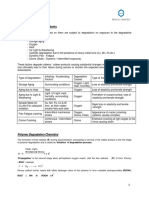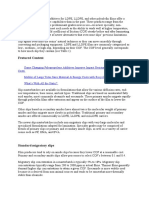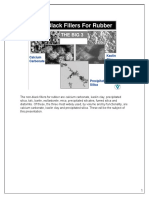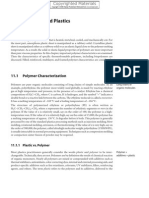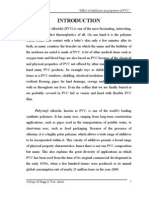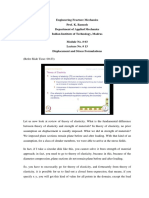0 ratings0% found this document useful (0 votes)
45 viewsAdditives: Fully Compounded
Additives
Uploaded by
Vy ThoaiCopyright
© © All Rights Reserved
Available Formats
Download as PDF, TXT or read online on Scribd
0 ratings0% found this document useful (0 votes)
45 viewsAdditives: Fully Compounded
Additives
Uploaded by
Vy ThoaiCopyright
© © All Rights Reserved
Available Formats
Download as PDF, TXT or read online on Scribd
You are on page 1/ 4
120 Chapter 4
• A Tg may be detected for the amorphous
phase present in a crystalline polymer.
• The amorphous phase in a crystalline poly-
mer can have profound effects on the poly-
mer's mechanical properties.
Polymer properties are significantly affected
by the degree of crystallinity. Crystallinity tends
to increase mechanical properties such as ten-
sile strength and hardness while diminishing
ductility, toughness, and elongation. The amor-
phous phase present in semicrystalline polymers,
however, can improve the toughness. Chemical
permeability and solubility generally decrease Figure 4-21
with increasing crystallinity. Crystalline polymers Typical forms of thermoplastic beads and pellets
are generally optically opaque or translucent,
whereas amorphous polymers have the greatest
optical clarity.
through a plate with many small holes. As the
Semicrystalline thermoplastics will gener-
polymer extrudate exits the extrusion die, the
ally shrink more than amprphous thermoplastics
molten polymer is simultaneously quenched in a
when cooled from the injection molding tem-
liquid bath and cut into small pellets with a knife.
perature. Over time, the crystallinity of a
The polymer pellets are removed from the bath,
semicrystalline plastic part may increase, causing
dried, and packaged for use. During the pelletiz-
dimensional changes (shrinkage). Amorphous
ing process, various additives are typically added
polymers are typically more dimensionally
to the polymer. Examples of typical polymer ad-
stable.
ditives are listed in Table 4-1.
Fully compounded resins have additives
added in the proper proportion through the en-
Additives
tire batch of resin. Alternatively, additives are
Engineering and commodity plastics, as well as sometimes added to a plastic by dispersing poly-
other polymeric materials such as paints and ad- mer pellets or beads that contain concentrated
hesives, use special additives to improve their additives into a base resin (virgin pellets or
properties and performance. Additives improve beads) before molding. Polymer pellets or beads
mechanical properties, thermal processing, sur- with concentrated additives are called master-
face characteristics, and chemical properties as batch resins. Color concentrates, for example,
well as appearance and aesthetic properties. are often added as masterbatch additions. In-
Additives may be incorporated into a poly- stead of purchasing large quantities of resins in
mer in various ways. In thermosetting polymers, various colors, using color concentrates allows a
for example, most of the additives are added to molder to buy large quantities of a naturally col-
the resin though special mixing and dispersion ored base resin and then control the color ofvar-
processes. Most thermoplastics are sold in the ious parts by adding a color concentrate.
form of small beads or pellets (Figure 4-21). The strength of a polymeric material may
Pellets and beads are made using a pelletizer be improved by using fillers such as glass, car-
machine, in which molten polymer is extruded bon or aramid (Kevlar®) fibers. The effect of
Principles of Polymeric Materials 121
Figure 4-22
Effect of glass-fiber reinforcement on the properties of nylon %
glass-fiber reinforcement on the properties of mer from sticking to processing equipment or to
a nylon thermoplastic is shown in Figure 4-22. itself.
Mineral fillers such as talc, ~ood pulp, milled Plasticizers are added to thermoplastics to
glass, mica, calcium carbonate, and so on may improve flexibility and toughness. Polyvinyl chlo-
be added to reduce the cost of a polymer resin ride, for example, is commonly plasticized for
or to increase dimensional stability and reduce applications such as automotive interiors. High-
shrinkage. The toughness of polymers is typically molecular-weight phthalate esters added to PVC
improved through the incorporation of impact increase the polymer's internal free volume, pro-
modifiers. High-impact polystyrene, for exam- viding more space within the polymer structure
pIe, contains small rubber particles (e.g., styrene for long-range motion of the polymer chains.
butadiene rubber) that are grafted to the main While improving flexibility, plasticizers reduce
polymer chain. The rubber particles arrest crazes the Tg, melt viscosity, and tensile strength of a
and cracks-thereby increasing the toughness thermoplastic (Figure 4-23). The solubility and
and fracture resistance of the material. chemistry of plasticizers in thermoplastics is im-
Lubricants such as molybdenum disulfide, portant, because plasticizers can migrate to the
graphite, silicone compounds, or fluoropolymers surface of a polymer, causing greasy films, or
(Teflon®) allow a polymer to be self-lubricating may vaporize from the surface, causing the ma-
for wear application such as bearings. Other lu- terial to become brittle. Certain phthalate esters
bricants (or slip agents) such as fatty acid es- such as di(2-ethylhexyl) phthalate (DEHP), used
ters migrate to the surface to help lubricate a in medical devices, food packaging, and chil-
polymer during processing to prevent the poly- dren's toys, have come under scrutiny by some
You might also like
- Graft Copolymers of Maleic Anhydride and Its Isostructural AnaloguesNo ratings yetGraft Copolymers of Maleic Anhydride and Its Isostructural Analogues63 pages
- Synhetic Rubber Mnufcturing: By: Syed Mehran FaridNo ratings yetSynhetic Rubber Mnufcturing: By: Syed Mehran Farid17 pages
- Project Report On Pigment Colour For PlasticsNo ratings yetProject Report On Pigment Colour For Plastics14 pages
- The World Rubber Industry - Review and Prospects To 2020 - Stephen Evans PDF100% (1)The World Rubber Industry - Review and Prospects To 2020 - Stephen Evans PDF42 pages
- Polymer Additives: Fillers & Reinforcements100% (1)Polymer Additives: Fillers & Reinforcements5 pages
- Classes of Polymeric Materials ElastomersNo ratings yetClasses of Polymeric Materials Elastomers71 pages
- Additives For Plastics Handbook - (Chapter 3. The World Market)No ratings yetAdditives For Plastics Handbook - (Chapter 3. The World Market)6 pages
- Solvent Cast Technology - A Versatile ToolNo ratings yetSolvent Cast Technology - A Versatile Tool14 pages
- Investigation of Mechanical Properties of Corn Fiber Reinforced With Biodegradable ResinNo ratings yetInvestigation of Mechanical Properties of Corn Fiber Reinforced With Biodegradable Resin4 pages
- Unit-Iii MANUFACTURING METHODS: Autoclave, Tape Production, Moulding Methods, FilamentNo ratings yetUnit-Iii MANUFACTURING METHODS: Autoclave, Tape Production, Moulding Methods, Filament13 pages
- Overview of Rubber Processing: - Tires Are Used in Large Numbers On Automobiles, Trucks, Aircraft, and BicyclesNo ratings yetOverview of Rubber Processing: - Tires Are Used in Large Numbers On Automobiles, Trucks, Aircraft, and Bicycles30 pages
- Effect of Stabilizers On Properties of PVC (Polymer) 1100% (5)Effect of Stabilizers On Properties of PVC (Polymer) 152 pages
- Impact of Lubricants On Processingbehaviour50% (2)Impact of Lubricants On Processingbehaviour5 pages
- Basics of Polymers Fabrication and Processing TechnologyNo ratings yetBasics of Polymers Fabrication and Processing Technology108 pages
- TYTAN Titanate Coupling Agent Overview - CCMB For Polyolefin 2018 06 v30% (1)TYTAN Titanate Coupling Agent Overview - CCMB For Polyolefin 2018 06 v325 pages
- Properties & Manufacturing & Applications & Limitations of PolymethylmethacrylateNo ratings yetProperties & Manufacturing & Applications & Limitations of Polymethylmethacrylate4 pages
- Characterization of Polymer Blends: Miscibility, Morphology and InterfacesFrom EverandCharacterization of Polymer Blends: Miscibility, Morphology and InterfacesNo ratings yet
- Polymer Morphology: Principles, Characterization, and ProcessingFrom EverandPolymer Morphology: Principles, Characterization, and ProcessingNo ratings yet
- Debinding Processes-: Friedherz H. Becker Riedhammer GMBH Klingenhofstrasse 72 90411 NürnbergNo ratings yetDebinding Processes-: Friedherz H. Becker Riedhammer GMBH Klingenhofstrasse 72 90411 Nürnberg21 pages
- Thomas Ha COMM1000 (MET2) - Audience Purpose Profile100% (1)Thomas Ha COMM1000 (MET2) - Audience Purpose Profile2 pages
- Phone Interview: 1. What Do You Know About Our Company?No ratings yetPhone Interview: 1. What Do You Know About Our Company?3 pages
- Temperature Control Using Labview and PLCNo ratings yetTemperature Control Using Labview and PLC6 pages
- Thomas Ha COMM1022 (MET2) - Appendix A - List of Project DeliverablesNo ratings yetThomas Ha COMM1022 (MET2) - Appendix A - List of Project Deliverables1 page
- (Thomas Ha) (CNC Block Plan Axis C) (Date: 28 Feb 2019)No ratings yet(Thomas Ha) (CNC Block Plan Axis C) (Date: 28 Feb 2019)1 page
- Ultimate Moment Capacity of Reinforced Concrete Section To EN 1992-2 - Clause 6.1No ratings yetUltimate Moment Capacity of Reinforced Concrete Section To EN 1992-2 - Clause 6.15 pages
- 2.4.3 Equilibrium Distribution of CarriersNo ratings yet2.4.3 Equilibrium Distribution of Carriers19 pages
- Nanolithography and Device Fabrication: Fall 2020/2021 NilNo ratings yetNanolithography and Device Fabrication: Fall 2020/2021 Nil40 pages
- Classes of Biomaterials: Ceramics, Glasses and Glass-CeramicsNo ratings yetClasses of Biomaterials: Ceramics, Glasses and Glass-Ceramics47 pages
- Engineering Fracture Mechanics Prof. K. Ramesh Department of Applied Mechanics Indian Institute of Technology, MadrasNo ratings yetEngineering Fracture Mechanics Prof. K. Ramesh Department of Applied Mechanics Indian Institute of Technology, Madras27 pages
- Bibliografie: and E. L. Rooy, Aluminum Alloy Castings: Properties, Processes, and Applications (ASMNo ratings yetBibliografie: and E. L. Rooy, Aluminum Alloy Castings: Properties, Processes, and Applications (ASM4 pages
- Lecture - 3 - COEM 6012 - Geotechnics in ConstructionNo ratings yetLecture - 3 - COEM 6012 - Geotechnics in Construction15 pages
- Wrought Alloys in Orthodontics ..Basic PropertiesNo ratings yetWrought Alloys in Orthodontics ..Basic Properties27 pages
- "Baseplt9" - Steel Column Base Plate Analysis: Program DescriptionNo ratings yet"Baseplt9" - Steel Column Base Plate Analysis: Program Description11 pages
- Bamboo As A Permanent Structural Component100% (4)Bamboo As A Permanent Structural Component56 pages
- Ming-Liang LI, Da-Sen BI, Jun-Ke HAO: Automotive Sheet Metal SAPH440 and Q235 Formability of Comparative Study100% (1)Ming-Liang LI, Da-Sen BI, Jun-Ke HAO: Automotive Sheet Metal SAPH440 and Q235 Formability of Comparative Study4 pages
- Hardin&Drnevich - 1972 - ShearModulusandDampinginSoils-DesignEquationsandCurvesNo ratings yetHardin&Drnevich - 1972 - ShearModulusandDampinginSoils-DesignEquationsandCurves27 pages
- Deflection: Virtual Work Method Trusses: Theory of Structure - INo ratings yetDeflection: Virtual Work Method Trusses: Theory of Structure - I26 pages
- Journal: Synthesis of Bifeo by Wet Chemical MethodsNo ratings yetJournal: Synthesis of Bifeo by Wet Chemical Methods5 pages
- Mechanics of Orthogonal Machining - Palmer and Oxley 1959100% (1)Mechanics of Orthogonal Machining - Palmer and Oxley 195934 pages
- Graft Copolymers of Maleic Anhydride and Its Isostructural AnaloguesGraft Copolymers of Maleic Anhydride and Its Isostructural Analogues
- Synhetic Rubber Mnufcturing: By: Syed Mehran FaridSynhetic Rubber Mnufcturing: By: Syed Mehran Farid
- The World Rubber Industry - Review and Prospects To 2020 - Stephen Evans PDFThe World Rubber Industry - Review and Prospects To 2020 - Stephen Evans PDF
- Additives For Plastics Handbook - (Chapter 3. The World Market)Additives For Plastics Handbook - (Chapter 3. The World Market)
- Investigation of Mechanical Properties of Corn Fiber Reinforced With Biodegradable ResinInvestigation of Mechanical Properties of Corn Fiber Reinforced With Biodegradable Resin
- Unit-Iii MANUFACTURING METHODS: Autoclave, Tape Production, Moulding Methods, FilamentUnit-Iii MANUFACTURING METHODS: Autoclave, Tape Production, Moulding Methods, Filament
- Overview of Rubber Processing: - Tires Are Used in Large Numbers On Automobiles, Trucks, Aircraft, and BicyclesOverview of Rubber Processing: - Tires Are Used in Large Numbers On Automobiles, Trucks, Aircraft, and Bicycles
- Effect of Stabilizers On Properties of PVC (Polymer) 1Effect of Stabilizers On Properties of PVC (Polymer) 1
- Basics of Polymers Fabrication and Processing TechnologyBasics of Polymers Fabrication and Processing Technology
- TYTAN Titanate Coupling Agent Overview - CCMB For Polyolefin 2018 06 v3TYTAN Titanate Coupling Agent Overview - CCMB For Polyolefin 2018 06 v3
- Properties & Manufacturing & Applications & Limitations of PolymethylmethacrylateProperties & Manufacturing & Applications & Limitations of Polymethylmethacrylate
- Biobased and Environmentally Benign CoatingsFrom EverandBiobased and Environmentally Benign Coatings
- Characterization of Polymer Blends: Miscibility, Morphology and InterfacesFrom EverandCharacterization of Polymer Blends: Miscibility, Morphology and Interfaces
- Polymer Morphology: Principles, Characterization, and ProcessingFrom EverandPolymer Morphology: Principles, Characterization, and Processing
- Debinding Processes-: Friedherz H. Becker Riedhammer GMBH Klingenhofstrasse 72 90411 NürnbergDebinding Processes-: Friedherz H. Becker Riedhammer GMBH Klingenhofstrasse 72 90411 Nürnberg
- Thomas Ha COMM1000 (MET2) - Audience Purpose ProfileThomas Ha COMM1000 (MET2) - Audience Purpose Profile
- Phone Interview: 1. What Do You Know About Our Company?Phone Interview: 1. What Do You Know About Our Company?
- Thomas Ha COMM1022 (MET2) - Appendix A - List of Project DeliverablesThomas Ha COMM1022 (MET2) - Appendix A - List of Project Deliverables
- (Thomas Ha) (CNC Block Plan Axis C) (Date: 28 Feb 2019)(Thomas Ha) (CNC Block Plan Axis C) (Date: 28 Feb 2019)
- Ultimate Moment Capacity of Reinforced Concrete Section To EN 1992-2 - Clause 6.1Ultimate Moment Capacity of Reinforced Concrete Section To EN 1992-2 - Clause 6.1
- Nanolithography and Device Fabrication: Fall 2020/2021 NilNanolithography and Device Fabrication: Fall 2020/2021 Nil
- Classes of Biomaterials: Ceramics, Glasses and Glass-CeramicsClasses of Biomaterials: Ceramics, Glasses and Glass-Ceramics
- Engineering Fracture Mechanics Prof. K. Ramesh Department of Applied Mechanics Indian Institute of Technology, MadrasEngineering Fracture Mechanics Prof. K. Ramesh Department of Applied Mechanics Indian Institute of Technology, Madras
- Bibliografie: and E. L. Rooy, Aluminum Alloy Castings: Properties, Processes, and Applications (ASMBibliografie: and E. L. Rooy, Aluminum Alloy Castings: Properties, Processes, and Applications (ASM
- Lecture - 3 - COEM 6012 - Geotechnics in ConstructionLecture - 3 - COEM 6012 - Geotechnics in Construction
- "Baseplt9" - Steel Column Base Plate Analysis: Program Description"Baseplt9" - Steel Column Base Plate Analysis: Program Description
- Ming-Liang LI, Da-Sen BI, Jun-Ke HAO: Automotive Sheet Metal SAPH440 and Q235 Formability of Comparative StudyMing-Liang LI, Da-Sen BI, Jun-Ke HAO: Automotive Sheet Metal SAPH440 and Q235 Formability of Comparative Study
- Hardin&Drnevich - 1972 - ShearModulusandDampinginSoils-DesignEquationsandCurvesHardin&Drnevich - 1972 - ShearModulusandDampinginSoils-DesignEquationsandCurves
- Deflection: Virtual Work Method Trusses: Theory of Structure - IDeflection: Virtual Work Method Trusses: Theory of Structure - I
- Journal: Synthesis of Bifeo by Wet Chemical MethodsJournal: Synthesis of Bifeo by Wet Chemical Methods
- Mechanics of Orthogonal Machining - Palmer and Oxley 1959Mechanics of Orthogonal Machining - Palmer and Oxley 1959





